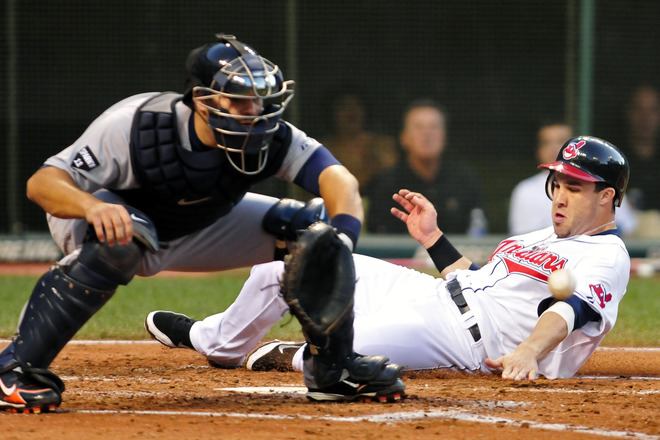 Indians Archive
Indians Archive  View from the Porch: A Need For Speed
View from the Porch: A Need For Speed
 The Indians have a need – a need for speed. I’m not talking about the kind that involves Keanu Reeves or Sandra Bullock. I’m also not referring to the kind that Josh Hamilton familiarized himself with in the early 2000s. I don’t mean the auto racing cable network nor do I mean the old Sony Playstation game.
The Indians have a need – a need for speed. I’m not talking about the kind that involves Keanu Reeves or Sandra Bullock. I’m also not referring to the kind that Josh Hamilton familiarized himself with in the early 2000s. I don’t mean the auto racing cable network nor do I mean the old Sony Playstation game.
I’m talking about distance divided by time and athleticism. I’m talking about throwing the ball past people, running down fly balls in the gap, and stealing bases. Speed, in a sporting sense, can cover up for a lot of flaws. In football, wide receivers that have drop problems or aren’t physical enough to make receptions in traffic can use their speed to get open and make easier catches. In hockey, smaller players with speed who can’t handle physical contact or get pushed off the puck can use their speed to elude defenders. In basketball, speed can create fast breaks or odd-man situations.
In baseball, speed can mean everything. Bat speed. Running speed. Pitch speed. Intellectual speed. Speed can create opportunities for your offense and take away opportunities for the opponent’s offense. It can turn tough plays into infield singles and put pressure on the defense. It can turn a pitcher with average command into a strike-throwing machine.
In this week’s View from the Porch, I’ll be getting more scientific than I ever did in my 16 years of schooling. (Also, I just realized I need a new picture for this article since I just got those beautiful, flowing locks chopped off on Thursday.)
Indians fans have been looking quizzically at each other with the starts to the season from Justin Masterson and Ubaldo Jimenez. More so with Masterson, but the problems with Jimenez are something that we hoped would be fixed and, so far, they haven’t been. All of the following data is from PITCH F/X and through April 26.
 Justin Masterson throws two types of fastballs, a four-seam fastball and a sinker (two-seamer).
Justin Masterson throws two types of fastballs, a four-seam fastball and a sinker (two-seamer).
Career
Total number of four-seam fastballs: 3,597
Average four-seam fastball velocity: 93.52 mph
Swing and miss percentage: 6.23%
Total number of sinkers: 4,459
Average sinker velocity: 91.65 mph
Swing and miss percentage: 8.84%
2011
Total number of four-seam fastballs: 1,376
Average four-seam fastball velocity: 94.19 mph
Swing and miss percentage: 7.19%
Total number of sinkers: 1,429
Average sinker velocity: 92.7 mph
Swing and miss percentage: 7.7%
2012
Total number of four-seam fastballs: 159
Average four-seam fastball velocity: 91.34 mph
Swing and miss percentage: 4.4%
Total number of sinkers: 139
Average sinker velocity: 89.93 mph
Swing and miss percentage: 10.07%
This data set tells us a lot of things. First, it tells us that Justin Masterson’s velocity is clearly down and it’s affecting his ability to throw the ball past hitters. Second, using other statistics such as walks and HR allowed, we can clearly see that Masterson has a smaller margin for error without his velocity. Third, because the sample sizes are rather large, we can assume that Masterson’s lowered velocity in 2012 has not skewed the results a whole lot and he was certainly throwing the ball harder in 2011 than during the rest of his career.
Obviously, the one outlier in all of this that is a positive is that Masterson’s getting more swings and misses with his sinker in the first month of 2012. As is to be expected, his sinker has more movement because it is taking a longer amount of time to get to home plate, thus making it more difficult for hitters to make contact.
This is a classic example of where statistics support what your eyes are seeing. Masterson’s giving up more home runs and has less margin for error. Why is that?
Well, for starters, consider the difference in reaction time according to this link (yes, it’s a softball website, but the chart has baseball pitch speed equivalents). In regards to Masterson’s four-seamer, the drop in velocity has changed the hitter’s reaction time from around .388 seconds up to roughly .4 seconds. While an extra .012 seconds may seem incredibly marginal, for athletes with the eyesight and reaction time that Major Leaguers have and continuously work to improve, it’s a very big difference. A difference like that not only allows hitters to make more contact, which they are clearly doing, but it also helps them lay off pitches outside the strike zone. The faster the pitch, the earlier the hitter has to swing, the more likely he is to swing at a bad pitch.
Everything a pitcher does is based around his fastball. If a pitcher’s fastball velocity is down, he has less margin for error. He’ll start aiming the ball and missing his spots. If he misses his spots, hitters can lay off the breaking ball and zero in on the fastball. That’s what hitters have been doing to Justin Masterson this year.
A late addition to this week’s VftP, Pitch F/X has the game data for Masterson’s Friday night start v. LAA. Of note: Masterson touched 95 with a sinker in the first inning, but his average four-seam velocity was 90.89 mph and his average sinker velocity was 89.68 mph. So, he was near his 2012 averages, but well below his career and 2011 averages. The key for Masterson was that he had quick innings because the Angels were hacking away.
 Ubaldo Jimenez is another victim of lost velocity. According to PITCH F/X, Jimenez also throws a four-seamer and a sinker (two-seamer).
Ubaldo Jimenez is another victim of lost velocity. According to PITCH F/X, Jimenez also throws a four-seamer and a sinker (two-seamer).
Career
Total number of four-seam fastballs: 4,234
Average four-seam fastball velocity: 95.9 mph
Swing and miss percentage: 8.95%
Total number of sinkers: 5,557
Average sinker velocity: 96.05 mph
Swing and miss percentage: 6.3%
2010
Total number of four-seam fastballs: 1,325
Average four-seam fastball velocity: 96.57 mph
Swing and miss percentage: 9.36%
Total number of sinkers: 846
Average sinker velocity: 97.04 mph
Swing and miss percentage: 6.5%
2011 & 2012
Total number of four-seam fastballs: 1,279 (1,047 + 232)
Average four-seam fastball velocity: 94.21/92.9 mph
Swing and miss percentage: 9.17/4.74%
Total number of sinkers: 1,053 (967 + 86)
Average sinker velocity: 93.7/92.32 mph
Swing and miss percentage: 5.27/5.81%
Without getting as technical as I did about Masterson, just ask yourself a simple question: What’s harder to hit: 96/ 97 mph or 92/93 mph? Jimenez has suspect command to begin with because of a long, lanky delivery with a lot of moving parts and a very high release point. You can get away with a lot of bad pitches if a hitter has around .377 seconds to react, which is literally about the time it takes to blink.
The consensus opinion is that a hitter has to start his swing about .2 seconds after the ball leaves the pitcher’s hand in order to get the bat fully through the zone to make contact. With that in mind, and the advanced ability of Major League hitters, you can see the difference that just a couple hundredths of a second can make.
As far as trying to explain why this is happening to both pitchers, your guess is as good as mine. Is Masterson experiencing a bit of a “dead arm” period after throwing a career-high 216 innings last season? Did Jimenez overdo it early in his career and is he trying to compensate now by becoming more of a pitcher than a thrower? Would that explain Jimenez insisting on throwing six-to-eight different pitch types per start?
Is it simply the cold weather? I asked a friend of mine, St. Ignatius High School senior southpaw Zak Shockley, about pitching in cold weather. He's extremely familiar with it thanks to the lovely early spring weather that his high school season is played in. One of the things that Zak mentioned was about grip. "Your fingers stiffen up and things don't flow like they can when it's warm and your body is real loose." He added, "the cold weather makes the leather slippery and, whether it happens naturally or voluntarily, that's another cause for a velo drop." Speaking as a true pitcher, however, Zak ended by saying "The cold is only as effective as you let it be. If anything, I think the cold overall gives an advantage to the pitcher."
Certainly, pitchers have a harder time loosening up their arms in the cold and can risk serious injury by overdoing it with their tight muscles. It’ll be something to monitor with Masterson, although the monthly Pitch F/X data does show an uptick in his velocity going from April to May. Hopefully, as the gametime temperatures go up, his ERA, WHIP, and BB/9 go down. The same can be said for Ubaldo Jimenez. Both guys should, however, be familiar to the cold as Masterson pitched at Beavercreek High School in Ohio and then a year at a junior college in Indiana. Jimenez definitely pitched in chilly conditions in Denver with the Colorado Rockies.
I may be overexaggerating the problems with Masterson. There's no doubt that the Jimenez velocity drop is not a new development, since it's been happening since day one of the 2011 season. It's just an interesting development to keep an eye on because it has to be part of the reason for both of their early season struggles.
I don’t think I need to elaborate on the drop of velocity that sent Rafael Perez to the disabled list yesterday. Obviously, relievers are significantly less effective with drops in their velocity because it is so crucial for relievers to miss bats and record strikeouts because they usually enter the game with runners on or are brought into matchup situations.
 So, I’ve covered pitchers, now what about hitters? The Indians entered play on Friday batting .237 as a team. They hit 16 home runs in their first nine games and that made their offense look a whole lot better than it is. Now that they aren’t hitting home runs and guys are really pressing at the plate, an effective running game would be a godsend. The Indians are slightly above the middle of the pack with 14 stolen bases but there are no “base stealers” on the team. Being able to swipe bags and effectively use the hit-and-run can drastically help an offense.
So, I’ve covered pitchers, now what about hitters? The Indians entered play on Friday batting .237 as a team. They hit 16 home runs in their first nine games and that made their offense look a whole lot better than it is. Now that they aren’t hitting home runs and guys are really pressing at the plate, an effective running game would be a godsend. The Indians are slightly above the middle of the pack with 14 stolen bases but there are no “base stealers” on the team. Being able to swipe bags and effectively use the hit-and-run can drastically help an offense.
If a runner steals second, it only takes one hit to score him instead of two. With a team of guys who don’t particularly hit for a high average, this takes off some of the pressure. Being able to get one run on two hits instead of having to put together an inning by stringing multiple hits together is good for everyone. Or, consider the hit-and-run. When the hit-and-run sign is on, the hitter has exactly one job – make contact. This simplified approach takes off the pressure. Guys aren’t trying to place balls for hits or find the hole between first and second. They’re simply trying to put the ball in play. Good things happen when hitters put the ball in play. Naturally, the Indians had two strikeout-caught stealing double plays in Friday’s game shortly after I wrote this section.
The Indians entered Friday leading the league in walks and were tied for the third-fewest strikeouts. With guys putting together good at bats and putting the ball in play, why not hit-and-run a little more often? You run the risk of getting a runner thrown out, but there are a lot of positive outcomes like stealing the base, a throwing error on the catcher, or, best case scenario, getting a hit and setting up a prime run-scoring opportunity.
Then, there’s the defensive element of having fast guys, specifically, in the outfield. When Johnny Damon gets here and Aaron Cunningham is (probably) sent down, that will leave the Indians with two below average defenders in LF, an average defender in CF, and an “oh shit!” defender in RF with a strong arm. With so many ground ball pitchers, it may not be the giant problem it could be with a big ballpark and a flyball staff, but there will be times where it hurts the Indians. The Indians are in this position because they refused to draft athletes in the high rounds of the draft during the 2000s.
The Indians drafted a dime-a-dozen 90 mph left hander in Sowers, a couple 1B/DH guys in Michael Aubrey and Beau Mills, an athletic player with tools but nothing that really stood out in Trevor Crowe, and really didn’t address the OF position with young talent. They’re paying for it now. While they poached Choo from the Mariners and Brantley from the Brewers, the last good outfield prospect that the Indians developed is probably Brian Giles. If you want to pick nits, you can argue that the Indians developed Choo, but as far as a completely home-grown outfielder, Giles is the guy. My apologies if I’m forgetting someone in between.
We’ve seen a shift in that ideology a little bit with the drafting of a very athletic and raw Francisco Lindor in 2011 and Levon Washington as a second rounder in 2010. It would behoove the Indians to take athleticism and talent and see if it can develop, for multiple reasons. You get guys that can steal bags, go first to third, score from second without a throw on a base hit, cover some ground in the field, etc., etc. You cannot overlook what speed can give a ballclub.
As per my usual framework for this column, I’ll end on a positive. It was nice for a walk-off winner on Friday night. The Indians battled. Sure, they squandered 11 baserunners against Jered Weaver, but they made him work and then got after the awful Anaheim bullpen. They struggled with the key hits, but they never quit and got a big win. It was definitely needed after losing two of three to the Royals.
Plus, it’s always nice to see, as Tom Hamilton calls them, a mob scene on the field.
- NBA Announces 2013-2014 Schedule
- Browns Ink Sharknado
- Sharknado A No-Show For Rookie Camp
- Trent Richardson Out Until Training Camp
- Browns Sign Brandon Jackson
- Carrasco Suspended Eight Games
- Browns Add to Wide Receiver Depth with David Nelson
- Browns Need to Learn from Past Draft Mistakes
- Browns Release Chris Gocong and Usama Young
- Browns Missing on Grimes Disappointing, But Not The End
The TCF Forums
- Chris Grant's first 3 drafts
Kingpin74 (Tuesday, January 21 2014 10:13 AM) - The 2014 Offseason Thread
googleeph2 (Tuesday, January 21 2014 9:36 AM) - 2015 Recruiting
furls (Tuesday, January 21 2014 6:57 AM) - Mike Brown
YahooFanChicago (Monday, January 20 2014 11:15 PM) - Movies coming out
HoodooMan (Monday, January 20 2014 9:34 PM) - 2014 Hoops Hockey Hijinx
jpd1224 (Monday, January 20 2014 4:44 PM) - 2014 Recruiting
jclvd_23 (Monday, January 20 2014 2:26 PM) - Wish List - #4 Pick
Hikohadon (Monday, January 20 2014 1:26 PM) - Official- Browns Coach Search/Rumors
OldDawg (Sunday, January 19 2014 6:48 PM) - #1 overall pick Anthony Bennett
TouchEmAllTime (Sunday, January 19 2014 1:28 PM)



